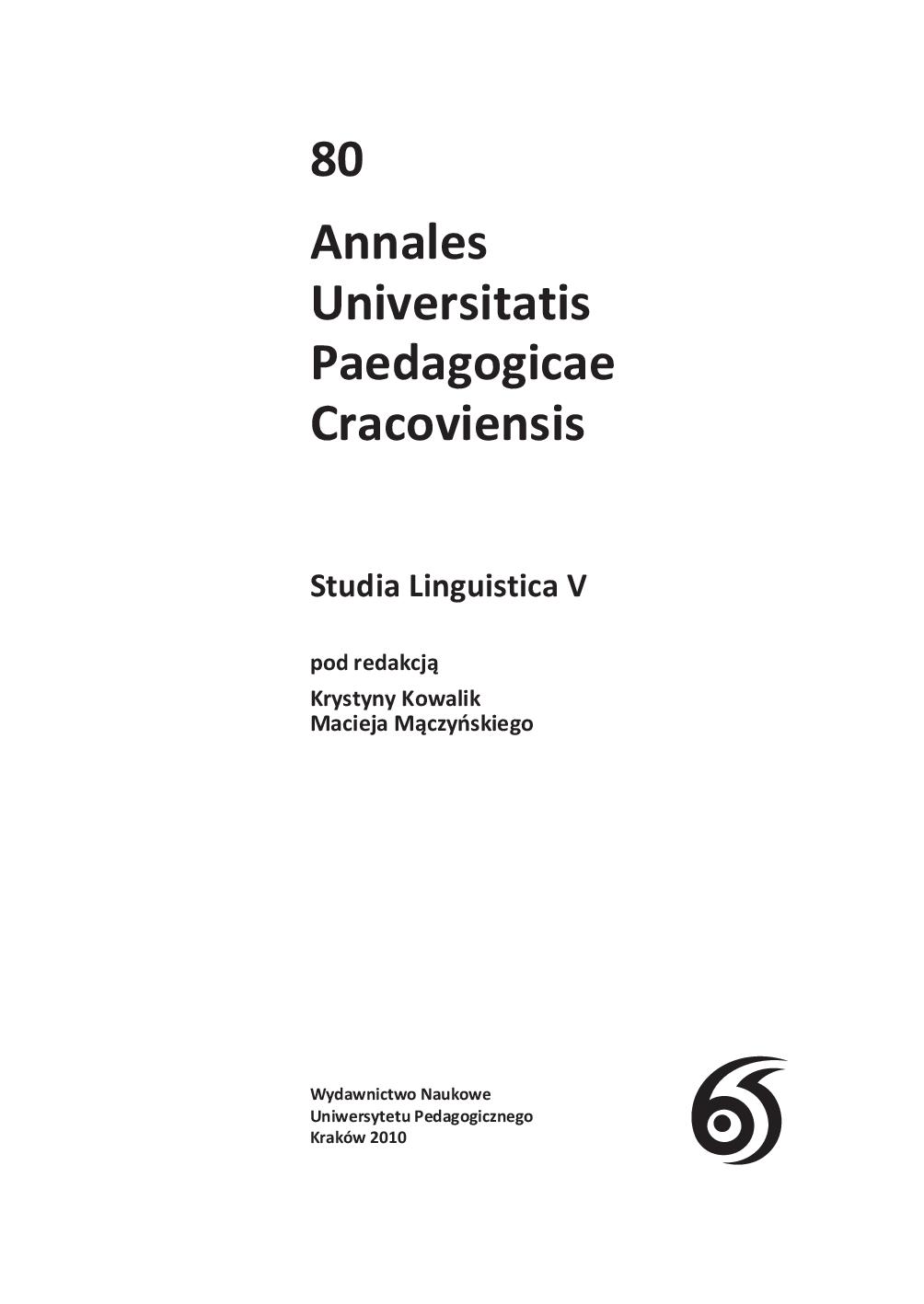Napisy na murach jako gatunek miejskiej polszczyzny pisanej
Main Article Content
Abstrakt
brick walls, board fences, and in public places”, as part of the written language of an urban
youth subculture, are seldom the subject of linguistic research and belong to the genre of
the street artistic work referred to as graffiti. The phenomenon of graffiti can be regarded
not only as a type of art (some murals can be found in New York galleries) but also as a sort
of mass social communication, especially at the level of words, i.e. the strictly linguistic one.
The urban space - walls, boards, public service vehicles (the underground, trains) - become
a specific medium and a special means of subcultural social communication in that way. Wall
inscriptions visually organise the urban space of interpersonal communication.
Vital features of that genre are humour and hybridity in respect of form - the message may
be a solely verbal one, a word may be accompanied by an image, but the message may also
be a drawing only (graphic form). All those features enable establishing graffiti as a separate
text genre of the urban written Polish language, whose feature, distinguishing it from other
types of expression, is its unique illocutionary power. Through that act of illocution, authors
of inscriptions want, at all cost, to achieve something in various spheres of reality, and in
particular to draw other people’s attention to what those other people allegedly do not notice
themselves.
Downloads
Article Details
Autor, zgłaszając tekst do redakcji czasopisma „Annales Universitatis Paedagogicae Cracoviensis. Studia Linguistica”, zaświadcza, iż jest on rezultatem wyłącznie jego własnej twórczości, że treść artykułu nie była dotychczas publikowana oraz że utwór nie narusza w żadnym stopniu praw autorskich ani praw pokrewnych innych osób, jak również innych praw osób trzecich, a także, że niczyje prawa do utworu (lub jego jakiejkolwiek części) nie zostały pominięte. Po podpisaniu umowy prawa majątkowe do opublikowanych materiałów zostają przeniesione na Wydawnictwo Naukowe Uniwersytetu Komisji Edukacji Narodowej w Krakowie.
Rocznik „Annales Universitatis Paedagogicae Cracoviensis. Studia Linguistica” to czasopismo o otwartym dostępie, a cała jego zawartość jest udostępniana bezpłatnie dla użytkowników i instytucji na zasadach licencji Creative Commons CC-BY-NC-ND 4.0 (uznanie autorstwa, użycie niekomercyjne, bez utworów zależnych). Na podstawie tej licencji autorzy zgadzają się, że ich prace mogą być zgodnie z prawem ponownie wykorzystywane do jakichkolwiek celów, za wyjątkiem celów komercyjnych, bez konieczności uzyskania uprzedniej zgody ze strony autora lub wydawcy. Każdy może prace te czytać, pobierać, kopiować, drukować, rozpowszechniać oraz przetwarzać, pod warunkiem poprawnego oznaczenia autorstwa oraz oryginalnego miejsca publikacji. Publikowanych tekstów nie można wykorzystywać do tworzenia utworów zależnych (np. do tłumaczenia ich i publikowania w innym języku bez zgody wydawcy). Jest to zgodne z definicją otwartego dostępu BOAI (Budapest Open Access Initiative) „Studia Linguistica”nie pobiera opłat za składanie artykułów ani ich przetwarzanie.
Autor, przesyłając artykuł do redakcji „Studia Linguistica”, bezwględnie zgadza się z poniższymi punktami:
-
Oświadczam, że jestem Autorem lub Współautorem nadesłanego tekstu. Przesłany tekst nie był nigdzie publikowany, jest całkowicie oryginalny i nie narusza w żadnym stopniu praw autorskich ani praw pokrewnych innych osób, jak również innych praw osób trzecich, a także, że niczyje prawa do utwory nie zostały pominięte.
-
Oświadczam, że nadesłany tekst nie został złożony do recenzji lub/i publikacji w innym czasopiśmie.
-
Przyjmuję do wiadomości, że Autor ponosi pełną odpowiedzialność za każdy przypadek plagiatu, niezależnie od tego, czy został on wykryty podczas procesu recenzji, czy po publikacji w „Studia Linguistica”.
-
Oświadczam, że ponoszę pełną odpowiedzialność finansową i prawną za wszelkie roszczenia związane z utworem.
-
Potwierdzam uznanie wszystkich źródeł danych wykorzystanych i cytowanych w badaniach.
-
Potwierdzam, że artykuł został wykonany z należytą starannością zgodnie ze standardami edytorskimi „Studia Linguistica”.
Bibliografia
Chmielewska N., 1995, Osobliwa technika językowa, „Polonica”, t. XVII, s. 109–120.
Google Scholar
Chrzanowska J.M. 2008, Anonimowość sztuki, „Preteksty”, nr 9, s. 19–23.
Google Scholar
Chudzik A., 2004, Uliczny dialog napisów, [w:] Język trzeciego tysiąclecia III, Kraków, s. 37–44.
Google Scholar
Kiliańska-Przybyło G., 1997, Humor napisów na murach – opis, analiza, interpretacja, [w:] Języ- ki specjalistyczne, język biznesu, red. J. Arabski, Katowice, s. 122–134.
Google Scholar
Michow E., 1995, Polskie graffiti, „Polonica”, t. XVII, s. 109–120.
Google Scholar
Miodek E., 2001, Graffiti we współczesnej kulturze językowej polskiej młodzieży, „Nauczyciel i Szkoła”, 3–4.
Google Scholar
Osęka A., 1990, Spowiedź uliczna, „Gazeta Wyborcza”, 29–30 IX.
Google Scholar
Rozmowa na początek wieku, z profesorem Aleksandrem Giesztorem rozmawiał paweł Wroński, „Gazeta Wyborcza” 13–14.02.1999, s. 10.
Google Scholar
Skubalanka T., 1999, Język graffitti, „Stylistyka”, t. 8, s. 89–104.
Google Scholar
Wojtak M., 2004, Gatunki prasowe, Lublin.
Google Scholar
Zellma A., Moralne aspekty graffiti, http://www.opoka.org.pl/biblioteka/Z/ZR/wychowanie/ moralneaspektygraffiti.html [dostęp 15.05.2008].
Google Scholar
